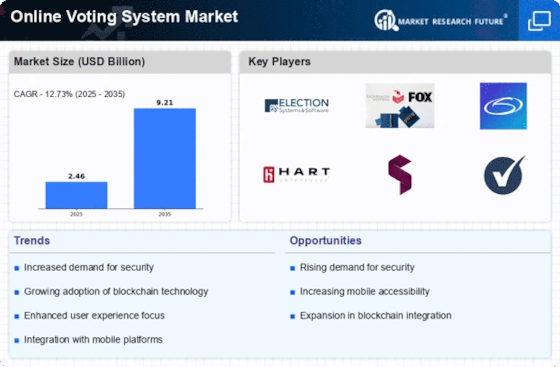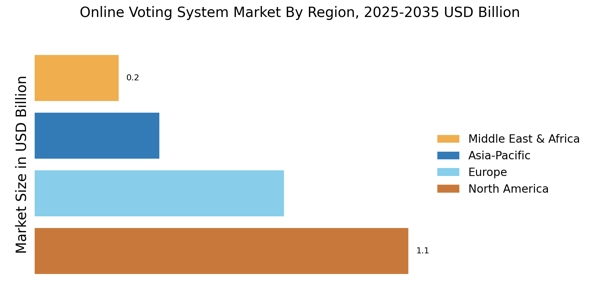Technological Advancements
The Online Voting System Market is experiencing a surge in technological advancements that enhance the efficiency and security of voting processes. Innovations such as blockchain technology and biometric authentication are being integrated into online voting systems, providing a more secure and transparent voting experience. According to recent data, the adoption of these technologies has the potential to increase voter trust and participation rates. Furthermore, advancements in mobile technology allow voters to cast their ballots from their smartphones, making the voting process more accessible. This trend indicates a shift towards more sophisticated online voting solutions, which could reshape the landscape of electoral processes in the coming years.
Rising Demand for Remote Voting
The Online Voting System Market is witnessing a rising demand for remote voting solutions, driven by the need for convenience and accessibility. As more individuals seek to participate in elections without the constraints of physical polling places, online voting systems are becoming increasingly appealing. Data suggests that jurisdictions implementing online voting have seen a notable increase in voter turnout, particularly among younger demographics. This trend reflects a broader societal shift towards digital solutions in various aspects of life, including civic engagement. The growing acceptance of remote voting could lead to a more inclusive electoral process, thereby influencing the future trajectory of the Online Voting System Market.
Increased Focus on Voter Privacy
In the Online Voting System Market, there is an increased focus on voter privacy and data protection. As concerns about data breaches and unauthorized access to personal information grow, online voting systems are being designed with enhanced privacy features. This includes end-to-end encryption and anonymization techniques that safeguard voter identities. Recent studies indicate that systems prioritizing voter privacy are more likely to gain public trust, which is crucial for the success of online voting initiatives. The emphasis on privacy not only addresses voter concerns but also aligns with regulatory requirements, potentially driving the adoption of online voting solutions across various regions.
Government Initiatives and Support
Government initiatives and support play a pivotal role in the Online Voting System Market. Many governments are actively exploring the implementation of online voting to modernize electoral processes and improve voter engagement. Legislative measures are being introduced to facilitate the adoption of online voting systems, with some countries allocating significant budgets for their development. For instance, recent government reports indicate that investments in online voting technology are expected to rise, reflecting a commitment to enhancing democratic participation. This support from governmental bodies is likely to accelerate the growth of the Online Voting System Market, as it fosters an environment conducive to innovation and implementation.
Growing Awareness of Election Integrity
The Online Voting System Market is increasingly influenced by the growing awareness of election integrity among voters and stakeholders. As public scrutiny of electoral processes intensifies, there is a heightened demand for transparent and verifiable voting systems. Online voting solutions that incorporate features such as audit trails and real-time monitoring are gaining traction as they address concerns about election fraud and manipulation. Data indicates that jurisdictions adopting such measures have reported improved public confidence in electoral outcomes. This focus on election integrity is likely to shape the development of online voting systems, ensuring they meet the expectations of a more informed electorate.


















Leave a Comment